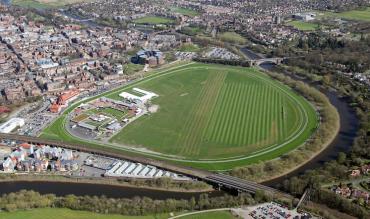Chester Racecourse is the oldest racecourse in England. Horse racing dates all the way back to this early 16th century track located on the banks of the River Dee.
Known in many quarters by its Roman name of the ‘Roodee’, Chester is also the country’s smallest flat racecourse at just 1 mile and 1 furlong long.
Its intimate size means racegoers can get greats views of the action from either up on the Roman walls overlooking the course or in the rather impressive County Stand.
There are few more thrilling sights in British Racing than the horses thundering into the final furlong at Chester- it is a vision to behold!
Biggest Races At Chester
The most notable races on the flat racing calendar at Chester take place at the May Festival. These races are very prominent in our sports betting markets.
The feature is the Chester Cup which is a 2 mile 2 furlong handicap race and the longest race on their calendar.
The Cheshire Oaks is a Listed race open to three-year-old fillies and the Chester Vase is a Group 3 flat race for three-year-old colts and geldings.
Chester Course Configuration
One major characteristic of Chester Racecourse is its unusually short straight which is only 239 yards long.
Horses that compete at Chester are almost on the turn throughout the entirety of any race and its tightness, coupled with the short run-in, means that most of the races are won by horses that race prominently at the front.
These idiosyncrasies are well worth knowing and digesting before you do any Chester horse race betting.
Chester Draw Bias
The 5f trip at Chester has long been one of the strongest draw biases in the country and season upon season there is always a significant advantage to being drawn low.
Looking at the data from 10+ runner handicaps over the last 20 years we can observe the following:
-
Top "third" of the draw: 8% of horses win.
-
Middle "third" of the draw: 25% of horses win.
-
Bottom "third" of the draw: 67% of horses win.
-
Over 50% of the races were won by stalls 1 or 2.
-
Over 6f low draws still hold the advantage although 6f races are quite as frequent as their 5f cousins.
-
Over 7f low to middle draws have continually had the edge, with low just edging it when the going is Good to Firm.
The extended 7f trip (7f 122yds) sees a wide open playing field in terms of the draw. That extra yardage gives some sprinters the opportunity to charge down the outside as the early leaders fold up.
Races contested over 1m2f, connections would marginally prefer to be drawn low rather than high, but it much of a muchness really in terms of coming home the winner.
Getting to Chester Racecourse
-
By Car - Chester Racecourse is easily reachable via car and is sign-posted from all major routes. The M53, M56, M6 and A483 are all in close proximity to Chester.
-
By Train - The railway station is a six-minute taxi ride to the racecourse, or a 20-minute walk.
*Credit for the photos in this article belongs to Alamy*
